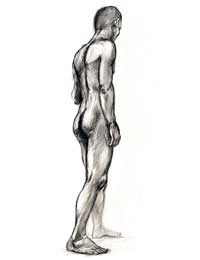Life Drawing

Life Drawing is the exercise of drawing the human form often, but not necessarily, nude. Life drawing is considered to be one of the most important drawing skills and one that is still essential to many jobs, especially in the advertising, film and animation sectors.
Life drawing has been central to the development of painting and drawing for the entire history of art and iconography, and a good grasp of how to draw the human form is still considered central to the development of an artist, even if they go on to work as an abstract or conceptual artist. This is partly for the intensity of the relationship that is struck up between the artist and the person they are drawing (often referred to as the ‘sitter’, even if they are stood up, or laying down)
. It is quite simply difficult to ignore the ‘otherness’ of the sitter – the artist really must engage with their presence in order to commit their image to paper. This has valuable lessons for all drawing as one must always really ‘engage’ with their subject to get anything out of drawing it. Otherwise the drawing can end up being merely a reflection of the artist’s inner thoughts and sensations.
Starting Life Drawing
Life Drawing is relatively easy to set up and merely involves getting someone to pose for you. Get them to pose in a position that they feel comfortable in. If you cannot afford an artists model, or cannot find an art class nearby (there are many evening life drawing classes) then try and get a friend or relative to sit for you. An arrangement between two artists, whereby they spend 10, for example, minutes alternately sitting for one another is ideal.Once you have the model and you're set up, tape an A1 piece of paper to a drawing board slightly bigger than A1 in dimension, before proceeding to draw the model in charcoal or pencil (the former is more forgiving, being easier to erase).
One thing you will notice is that your drawing may not resemble your sitter very closely at first. One problem is that people rarely perceive anatomy as it really is. The mind tends to caricature and pronounce parts of the body such as the head and the hands, whilst reducing in size the arms and legs. This is because the mind retains information about the parts of the human body that are most conducive to communication, whilst reducing in importance other parts of the anatomy.
Because of this, life drawing really entails having to look at the sitter. It also entails having to acknowledge the presence of the sitter as a real thing, outside of your own experience. This latter point is essential to understanding art better, so really try and become involved with this aspect of life drawing.
The key to life drawing is the observation of the sitter and an acknowledgment of your attempt to present their reality on paper, coupled with your attempt to convey the experience of looking at the sitter.


Re: Contextualising Your Work
Dear Mr Watson, I have been working relentlessly for 40 years through Art, writing, performance based expressions in theatre, dance,…
Re: How to Sell My Paintings and Drawings?
Hi , I would like say about my cousin that he live in Afghanistan and he is fabulous in art painting and doing job…
Re: How to Sell My Paintings and Drawings?
Amy - Your Question:Hi I have just left school and I love to draw I do pencil work and I would love to sell my…
Re: How to Sell My Paintings and Drawings?
Hi I have just left school and I love to draw I do pencil work and I would love to sell my drawing but I don't no how…
Re: How to Sell My Paintings and Drawings?
Hi, I have 3 drawings the information as follows: 1- Salvador Dali (Spanish Draftsman). Is 24x19 cm. 2- Pablo…
Re: Freeing Yourself Up
I love drawing so much and I will like to be one of the best artist in the world
Re: How to Sell My Paintings and Drawings?
anna-81 - Your Question:Hi, I need help how can I sale my paintings and drawings and I want to know if my work is…
Re: How to Sell My Paintings and Drawings?
Hi, i need help how can i sale my paintings and drawings and i want to know if my work is really good or not. I'm…
Re: How to Sell My Paintings and Drawings?
i want to sell my drawing give me the idea.
Re: How to Sell My Paintings and Drawings?
I am 15 years old and i would like to sell my pencil drawing